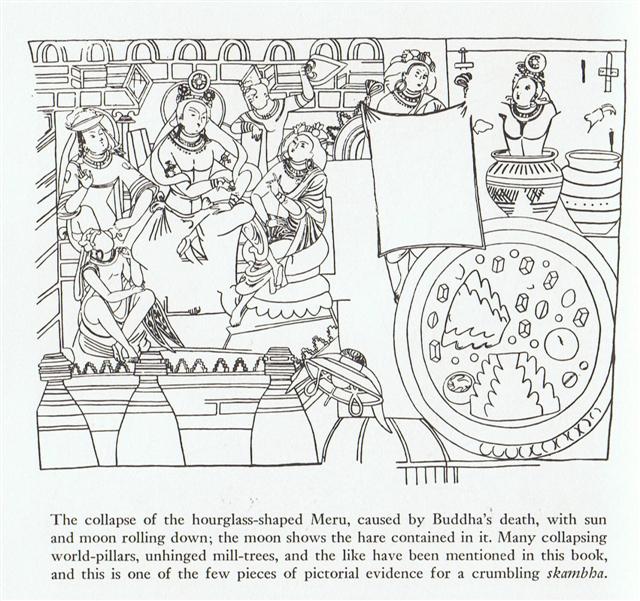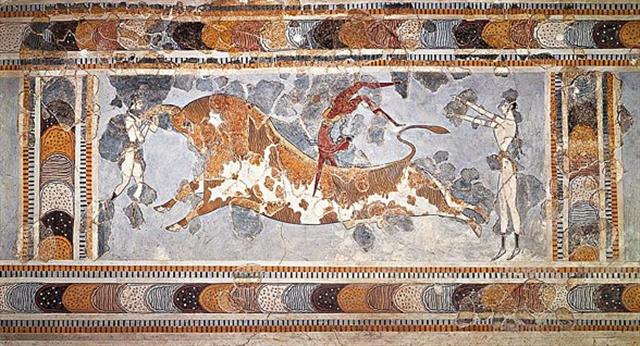|
THE D
TABLET
It might be regarded as absurd that the calendar would make a sudden jump from right ascension day *65 at Ain in the Taurus constellation to *249 at Antares in the constellation of the Scorpion.
However, it was said that the third husband of Atea was named Fa'a-hotu, Make Fruitful (→ 'Ripens All Fruit' → Antares). Instead of perceiving a sudden jump half a year across the sky we could envision some hidden path behind the cloud cover or under ground for the Sun to follow, measuring for instance 3 times 177 = 531 days.
Although in a Sun calendar the measure for such a hidden path should rather be founded on the idea of 3 * 182 = 546 days. 145 (290 / 2) + 364 /2 (182) = 327 is quite close to 329 (November 25). But the path of the Earth around the Sun is not a perfect circle and therefore we should at present in the Milankovic Ice Age cycle count 145 + 184 = 329. Nevertheless 3 * 182 = 546 = 64 + 2 * 241 (the measure carried on the Phaistos Disc) = 2 * 273 (as in the day number for September 30) = 6 * 91. For 'sacred numbers were never chosen haphazardly'. In other words, the path for the Sun from Ain in the Bull should ideally stretch for 3 halfyears (misseri years) in order to reach the place where Ain would be at the nakshatra Full Moon.
In the Golden Age of the Bull the Sun would have risen in day 1 after MARCH 21. And 1 + 184 = 185 was at SEPTEMBER 22 (265, *185, EQUINOX). Here the Sun would have been at Antares (*249 - *64 = *185) and here was the beginning of 'the year in leaf' for those who lived south of the equator. Somewhere in this explanatory (extraplanetary) circus ... What happens after (or happened, or will happen sometime, for this myth is written in the future tense), is told in the Völuspa, but it is also amplified in Snorri's Gylfaginning (53), a tale of a strange encounter of King Gylfi with the Aesir themselves, disguised as men, who do not reveal their identity but are willing to answer questions: 'What happens when the whole world has burned up, the gods are dead, and all of mankind is gone? You have said earlier, that each human being would go on living in this or that world.' So it is, goes the answer, there are several worlds for the good and the bad. Then Gylfi asks: 'Shall any gods be alive, and shall there be something of earth and heaven?' And the answer is: 'The earth rises up from the sea again, and is green and beautiful and things grow without sowing. Vidar and Vali are alive, for neither the sea nor the flames of Surt have hurt them and they dwell on the Eddyfield, where once stood Asgard. There come also the sons of Thor, Modi and Magni, and bring along his hammer. There come also Balder and Hoder from the other world. All sit down and converse together. They rehearse their runes and talk of events of old days. Then they find in the grass the golden tablets that the Aesir once played with. Two children of men will also be found safe from the great flames of Surt. Their names, Lif and Lifthrasir, and they feed on the morning dew and from this human pair will come a great population which will fill the earth. And strange to say, the sun, before being devoured by Fenrir, will have borne a daughter, no less beautiful and going the same ways as her mother.' Then, all at once, concludes Snorri's tale wryly, a thunderous cracking was heard from all sides, and when the King looked again, he found himself on the open plain and the great hall had vanished ...
there should also be 6 'sleeping mats'. A half-year should in principle measure 366 / 2 = 183 days. But the measure given by the Full Moon was 177 nights = 183 - 6. I am now quite convinced we should go ahead with listing stars and dates following the method suggested above and therefore begin with Antares ideally at the Full Moon:
And we should here compare the pair Da1-2--3 with the pair Ga1-3--4:
In May 28 (*68) Itzam-Yeh (Ursa Major) had been defeated. Since then (3149 BC) precession would have carried the fixed stars ahead with around 70 days, which implies we could look for signs of Itzam-Yeh around right ascension day *68 + *2 = 150 (May 30). Cfr Ga1-6 resp Ga7-19 (188 = 6 + 182):
Although anciently they had waited for 16 days in order to observe the return to visibility of the stars (having survived the hot rays from the Sun). ... Like the sun, chiefs of the highest tabus - those who are called 'gods', 'fire', 'heat', and 'raging blazes' - cannot be gazed directly upon without injury. The lowly commoner prostrates before them face to the ground, the position assumed by victims on the platforms of human sacrifice. Such a one is called makawela, 'burnt eyes' ... Which means we should look for day 150 - 16 = 134 (May 14 = MARCH 11, *355 → December solstice), i.e. the day immediately preceding the Pleiades. We can here compare Gb8-21 (MARCH 11, 70, 365 + 70 = 435,.*355) with the last glyph on the D tablet and find the key number 107 explained as 435 - 328:
The strange hau tea with 4 feathers at left and 4 in front is a rare beast, but I can find a similar one at the end of the text on the Santiago Staff:
4 + 4 + 5 (Da1-19) = 13 →
|












